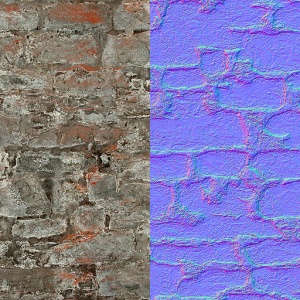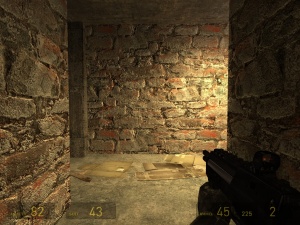$bumpmap
Jump to navigation
Jump to search

A material's albedo (left) compared to its normal map.
The $bumpmap VMT parameter specifies a texture that will provide three-dimensional lighting information. The texture is known as a Normal Map.
Basic syntax
$bumpmap <texture>
LightmappedGeneric { $basetexture brick/brickwall021a $surfaceprop brick $bumpmap brick/brickwall021a_normal }
Additional parameters
$bumptransform <matrix>- Transforms the bumpmap texture. Requires DirectX 9 or above.
- The default position is
center .5 .5 scale 1 1 rotate 0 translate 0 0.centerdefines the point of rotation. Only useful ifrotateis being used.scalefits the texture into the material the given number of times.2 1is a 50% scale in the horizontal X axis while the vertical Y axis is still at original scale.rotaterotates the texture counter-clockwise in degrees. Accepts any number, including negatives.translateshifts the texture by the given numbers..5will shift it half-way. 1 will shift it once completely over, which is the same as not moving it at all.
 Note:All values must be included!
Note:All values must be included! Bug:Scaling the texture may cause odd issues where the Texture Lock tool in Hammer will not actually lock the texture in place. [todo tested in ?]
Bug:Scaling the texture may cause odd issues where the Texture Lock tool in Hammer will not actually lock the texture in place. [todo tested in ?] Bug:Rotating textures applied on brushes will rotate around the map origin (confirm: Orangebox engine only?). A fix for this is to change the center position in the VMT to the brush's origin. [todo tested in ?]
Bug:Rotating textures applied on brushes will rotate around the map origin (confirm: Orangebox engine only?). A fix for this is to change the center position in the VMT to the brush's origin. [todo tested in ?]
$bumpscale <float>- Scales the normal map by the given value in DirectX 8.
$bumpframe <integer>- Frame number to use from an animated texture.
$nodiffusebumplighting <bool>- See Dealing with fillrate issues. Only relevant when using LightmappedGeneric.
$forcebump <bool>- Forces DirectX 8 cards to render the bump map. They normally don't for performance reasons.
$bumpoffset <?>- Todo: dx8 version of center?
$bumpmap2 <texture>$bumpframe2 <integer>- Used by the WorldVertexTransition shader in blend materials that display two textures. DirectX 9 required.
